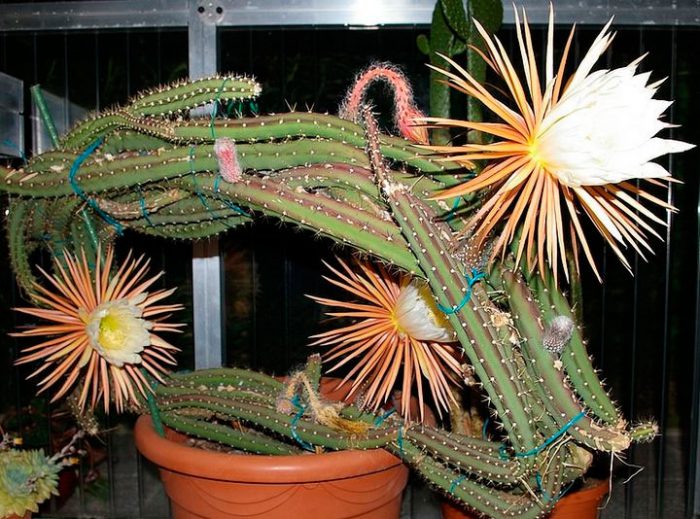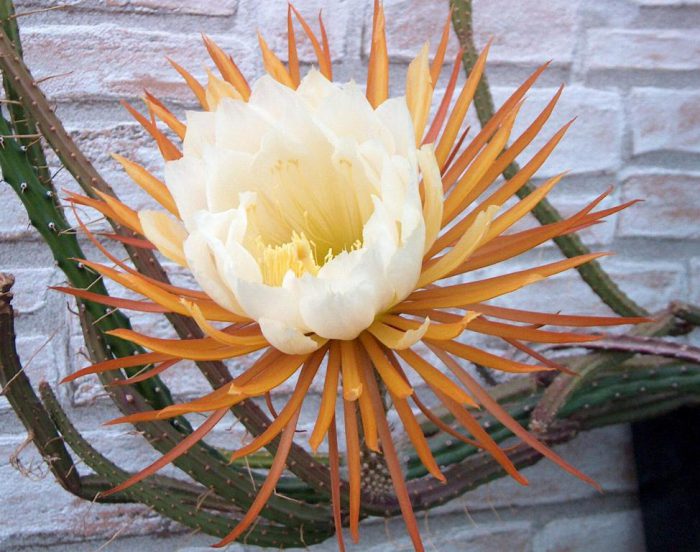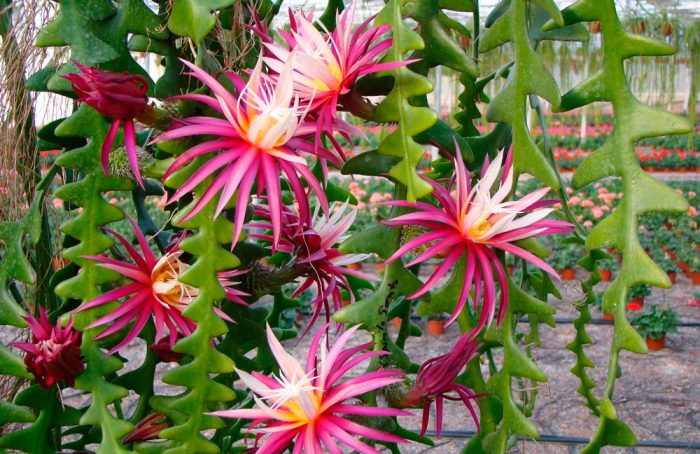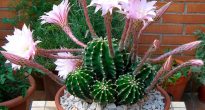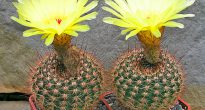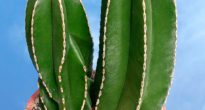Kind of like Selenicereus (Selenicereus) is directly related to the cactaceae family (Cactaceae). It unites 24 plant species, among which there are epiphytic, terrestrial, and also lithophytic. In nature, they are found in shady rainforests, as well as on the rocks of South and Central America. This genus stands out from the rest in that it has thin multi-ribbed shoots-lashes, from which many aerial roots extend. It is these roots that help the plant attach to a variety of supports. These shoots are very long (up to 12 meters), but they are rather thin, for example, their diameter is only 3 centimeters.
This species still differs from the others in that it has the largest flowers. There are species in which flowers can reach 30 centimeters in diameter, while the corolla tube is very long (up to 40 centimeters). Also, the flowers are quite complex. Outwardly, they bear some resemblance to water lilies. The perianth has many narrow (almost filamentous) outer lobes that are dark in color, while the colors can be different, for example, yellow, brown, pink or red. The wide inner lobes are white. They can either completely fill the inner part of the flower, or open up in a bowl-like shape.
Also, this plant has a very interesting formation of buds. They form as if in a nest, while at first they resemble a tight ball of whitish hairs. As a rule, 20 days after the beginning of formation, the leathery tip of the bud becomes visible.
In any species of Selenicereus cactus, flowers bloom in the evening, and even before dawn they wither. Thanks to this feature, this plant received its second name “Queen of the night».
Selenicereus home care
Most likely, this plant is not very popular with flower growers, because there are unfounded assumptions that caring for it is incredibly difficult. However, this is not at all the case.
Illumination
This is a very light-loving cactus, which is not harmed by the direct rays of the sun. In this regard, it is recommended to place it near a south-facing window.
Temperature regime
In summer, the plant feels quite well at temperatures typical for central Russia.In winter, there is a dormant period and it is best to move the cactus to a cool place (15 to 17 degrees).
Do not forget that Selenicereus reacts extremely negatively to sudden temperature changes and drafts. If the environmental conditions are not favorable for the development and growth of the cactus, then it can throw off all the buds that have appeared.
How to water
Watering is carried out only after the top layer of the substrate is thoroughly dry. The bay is very undesirable for this plant, as it can form rot, which will lead to death.
Watered with soft, well-settled water, which must be at room temperature. You can soften it with acetic or citric acid (the taste should be completely imperceptible).
Humidity
It grows and develops well with the usual air humidity of city apartments. Selenicereus does not need additional spraying. For hygienic purposes, its stems can be washed with lukewarm water.
Earth mix
Suitable soil should be nutrient-dense and have good water and air permeability. For planting, a purchased earthen mixture for succulents and cacti is quite suitable. However, experienced flower growers recommend pouring into it not a very large amount of broken brick or small expanded clay. Also, to prevent the development of root rot, you can add crushed charcoal.
Don't forget to drain well at the bottom of the pot.
Fertilizer
This cactus is fast growing and needs a lot of nutrients. So, regular feeding is carried out during the period of intensive growth 2-3 times a month. For this, universal fertilizers for cacti are used. In the period November – March, fertilizers cannot be applied to the soil.
Transplant features
Young cacti need an annual transplant, which is carried out in the spring. Mature plants that have grown quite large can only be replanted if absolutely necessary. If the selenicereus grows without transplants, then experts advise every year to replace the top layer of the substrate in the pot with a new one. In this case, it is necessary to clean off the old layer carefully until the roots appear.
Trimming and shaping
Those stems that are unattractive and very long can be removed by pruning, as the plant is able to recover from damage. However, formative pruning should not be carried out, because it does not affect tillering and after it there will be ugly stumps. If you carry out a very strong pruning, then this can lead to the death of the cactus.
For the formation of a plant, it is recommended to use a variety of supports, rings, ladders, which are wrapped with thorny shoots. However, you must be very careful, because the stems of the cactus are fragile and easily damaged when you try to bend them.
Reproduction methods
Can be grown from seed as well as cuttings. The latter are rooted in the spring in a damp earthy mixture.
Diseases and pests
Can settle on a cactus shield or spider mite... If pests are found, then the cactus will need to be treated with an appropriate chemical.
When overflowing, rot may appear on the roots.
Main types
Selenicereus grandiflorus (Selenicereus grandiflorus)
Despite the fact that flowering is quite spectacular in all species of this genus, only one of them is most popular - Selenicereus large-flowered. It has very long climbing shoots. In the wild, these shoots often become tangled in thorny balls. Slightly wavy stems are quite thin, so, their thickness is only 2.5 centimeters. On their faces, which are 7 or 8 pieces, there are small areoles with a whitish-gray edge. From each areola grow from 5 to 18 short spines, the length of which is 0.5-1.5 centimeters. As the stem matures, these thorns die off. The flowers of this cactus are very fragrant and their smell is similar to vanilla.The flower is very large, so, when opened, its diameter is 30 centimeters. The tube grows up to 22 centimeters long. At the perianth, the narrow-lanceolate outer lobes are pale brown, they reach 7 to 10 centimeters in length and 4.5 centimeters in width. The inner lobes broadly lanceolate with a narrow tip are slightly shorter than the outer ones. Of these, 2 or 3 not very dense loose layers are formed. In the core there are many yellowish stamens, the length of which is 5 centimeters. When flowering ends, purple egg-shaped fruits are formed. Their length, as a rule, does not exceed 8 centimeters.
This plant has a fairly long flowering. So, it can bloom throughout the summer, even despite the fragility of the flower (it fades a few hours after opening). The fact is that during flowering, a cactus can form up to 50 buds.
Selenicereus anthonyanus
It is also a very spectacular type of Selenicereus, but it is not yet in great demand among domestic growers. This cactus is also popularly called "fish bone". This climbing plant has flat, leafy and rather fleshy shoots, which are also very wide (up to 15 centimeters). A deeply dissected greenish-blue shoot is similar in shape to an oak or dandelion leaf, while its lobes are unpaired. Three short spines each protrude from comparatively small areoles. The diameter of the flower in the open state is 20 centimeters, and the length of the tube is 12 centimeters. The perianth has an unusual color of the lobes. So, the color smoothly changes from purple on the outside to creamy pink on the inside. The length and shape of these lobes are almost the same. The lobes of both the inner and outer parts are almost equal in width. Their length gradually increases from the center to the edges. There are a lot of them, so the space inside the flower is completely filled. Short, yellowish stamens are almost invisible under a large pink-white pistil with a star-shaped stigma.
Selenicereus hook-shaped (Selenicereus hamatus)
This is also a very spectacular look, but it is very rare to find it in the collections of gardeners. The shoots have a rich green color in length up to 12 meters, they have 4 or 5 ribs. On these ribs there are relatively large hook-shaped spurs-processes, the length of which is 1 centimeter. 5 pieces of short (5 millimeters) spines protrude from areoles, very similar to whitish-yellow stamens. Quite large flowers in the open state have a diameter equal to 20 centimeters, there is also a long tube - up to 40 centimeters. The rather wide lanceolate lobes of the perianth, located in the outer part, are colored light green, and those that are inside are almost oval in shape. The lobes fit quite tightly to each other, while almost completely covering the neighboring ones. Due to this, they form a bowl shape. Light yellow long stamens mixed with many long outgrowths of pistils (up to 18 pieces).

